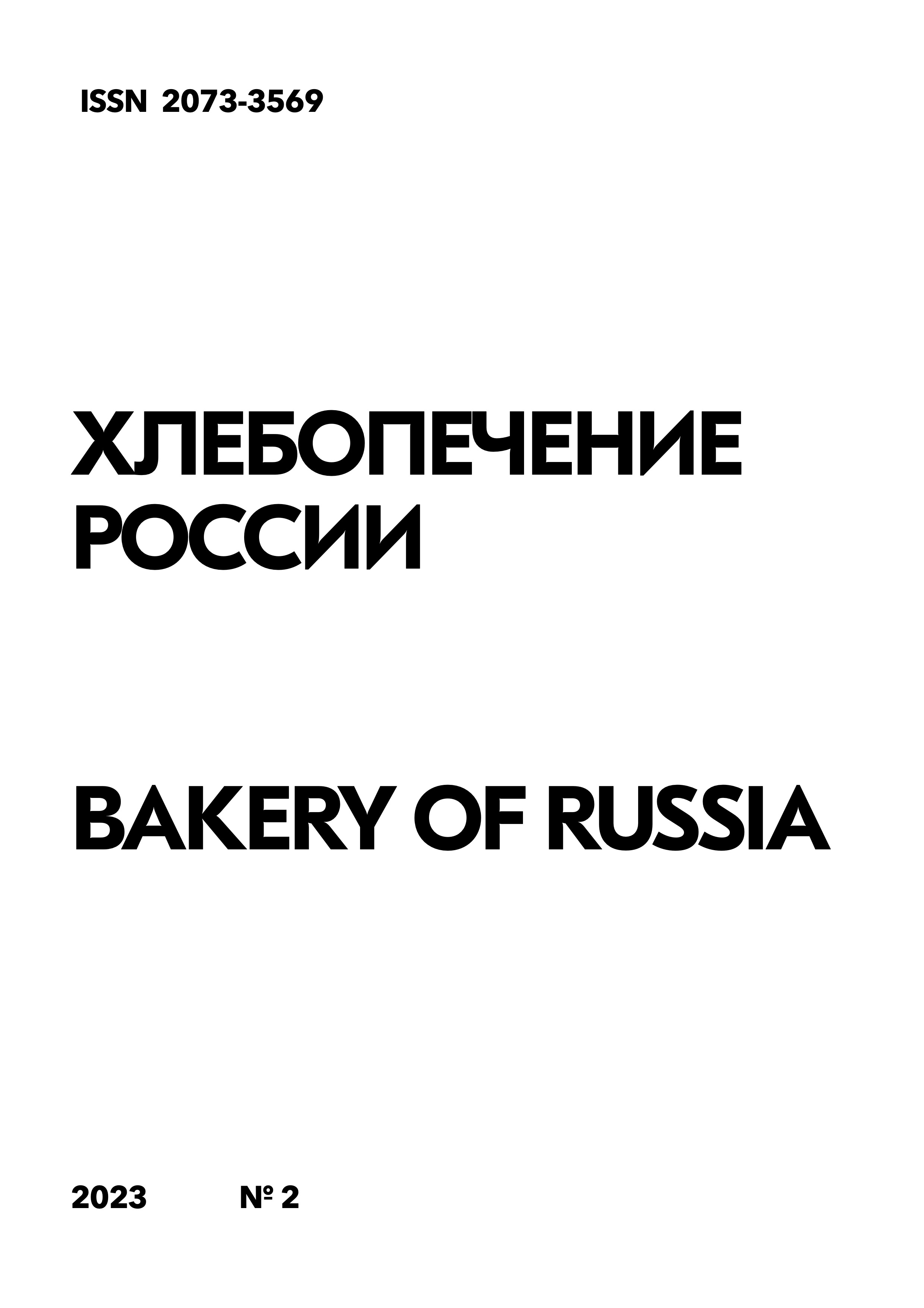Analysis of the prospects for multi-purpose classification of bakery products using L. Euler circles through a categorical triplex: purpose-raw materials-technology
Keywords:
classification, L. Euler circles, bakery products, classification signs, raw materials, purpose, technologyAbstract
Relevance. In the context of global changes in the consumer market, the expansion of the current range of bakery products, the launch of new products with additional consumer properties, the development of new baking technologies, including innovative techniques, new approaches to the classification of bakery products are required. In order to find common ground between the tasks of producers, sellers, consumers and government agencies, L. Euler's method for creating a multifunctional classification of bakery products was first proposed. It seems appropriate for the authors to consider the triplex “purpose-raw materials-technology” as a fundamental factor in the formation of new approaches to classification, which will most fully characterize the entire current and projected range of bakery products. Purpose of the study: to develop a classification method based on the analysis and optimization of existing approaches to the classification of bakery products, taking into account global challenges. Materials and methods. A systematic approach, hierarchical and facet classification methods, content analysis of publications, and L. Euler’s method were used. Scientific sampling allowed us to cover a wide range of methods for analyzing and identifying criteria for the classification of bakery products. The identified criteria were compared and allocated into the most homogeneous groups with multi-level structuring: fundamental criteria (categorical triplex) - secondary criteria (within the framework of the fundamental criterion) - subordinate criteria (varying depending on the classification tasks). Objects of research: federal and industry regulations, FIPS patent database, catalogs of online stores of popular Russian and foreign retail chains. Results. As a result of the analysis and synthesis of the identified criteria for bakery products, approaches to creating a multi-purpose classification using L. Euler circles are demonstrated. The need to create an elastic classification, with the possibility of its transformation for given purposes, is emphasized. The practical implementation of the proposed approach to the classification of bakery products is demonstrated using the example of three samples of bakery products, which differ as much as possible within the framework of secondary criteria, demonstrating the possibility of changes to suit the tasks of applying the classification. Conclusions. The resulting classification has all the advantages of a hierarchical classification; it is more informative and deeper than the facet classification, while providing variability and versatility. This classification will be useful in justifying directions for the development of new food products, choosing technology and raw materials, developing a strategy for creating specialized products, and ensuring compatibility with other classification systems used in various countries and industries for the purposes of international trade and standardization. This model can be used to create interfaces and catalogs for online retail businesses. The authors see the prospects for improving the methodology as expanding the range of subordinate criteria due to their deeper specialization. This classification technique can also be scaled to other homogeneous groups of food products.
References
алых предприятиях РФ" // Известия Оренбургского государственного аграрного университета. 2019. № 1 (75). С. 82-85
Белявская И.Г. Научно-практические основы технологии хлебобулочных изделий с направленной коррекцией пищевой ценности и антиоксидантных свойств: специальность 05.18.01 "Технология обработки, хранения и переработки злаковых, бобовых культур, крупяных продуктов, плодоовощной продукции и виноградарства": диссертация на соискание ученой степени доктора технических наук. 2019. 381 с. EDN OVZBMF.
Влащик Л.Г., Багдасарова М.П. Технохимический контроль сырья и продуктов питания: практикум: учебное пособие. Краснодар: Кубанский государственный аграрный университет, 2019. 210 с. URL: https://e.lanbook.com/book/315734
Гарин Е.В. "Иерархия потребностей человека" // Векторы благополучия: экономика и социум. 2014. № 2 (12). С. 168-181.
Жаркова И.М. Научно-практическое обоснование и разработка технологий специализированных мучных изделий: специальность 05.18.01 "Технология обработки, хранения и переработки злаковых, бобовых культур, крупяных продуктов, плодоовощной продукции и виноградарства": диссертация на соискание ученой степени доктора технических наук, 2017. 453 с. EDN QOUAFC.
Китаевская С.В. "Моделирование ферментной композиции и ее применение в криотехнологии хлебопечения" // Индустрия питания. 2023. Т. 8. № 1. С. 5-13.
Лукашов И.М., Корабельникова А.А., Минайченкова Е.И., Положенцева И.В. Управленческий анализ национального проекта «демография» с использованием диаграмм эйлера –венна // Журнал прикладных исследований. 2021. Т. 2. № 1. С. 25-35.
Соколов А.П., Гарбар Т.В. Трудности муниципального программирования социально-экономического развития // Экономика. Инновации. Управление качеством. 2014. № 4 (9). С. 117.
Стуликова М.Н., Филатов В.В. Функциональные, менторские, социальные и духовные направления деятельности российских предпринимателей // Всероссийская научная конференция молодых исследователей с международным участием, посвященная Юбилейному году в Российский государственный университет им. А.Н. Косыгина «Экономика сегодня: современное состояние и перспективы развития» (Вектор-2020): сборник материалов всероссийской научной конференции молодых исследователей. Москва, 2020. С. 104–107.
Суконько Н.А. Актуальные вопросы классификации молочных товаров в соответствии с ТН ВЭД ЕАЭС // Развитие таможенного дела Российской Федерации: дальневосточный вектор. 2021. № 1. С. 204-208. DOI:10.24412/cl-36450-2021-1-204-208
Бисчокова Ф.А. Учебное пособие по дисциплине «Технология национальных мучных изделий» для студентов направления подготовки 19.03.02 «Продукты питания из растительного сырья» всех форм обучения: учебное пособие. Составитель Ф.А. Бисчокова. Нальчик: Кабардино-Балкарский государственный аграрный университет. Лань: электронно-библиотечная система. 2019. 163 с. URL: https://e.lanbook.com/book/137655
Эйлер Л. Метод нахождения кривых линий, обладающих свойствами максимума, либо минимума или решение изопериметрической задачи, взятой в самом широком смысле. Москва; Ленинград: Гостехиздат, 1934. 600 с.
Belyavskaya I.G., Matveeva I.V., Bogatygeva T.G. Enzyme Application for Enhancement of the Bread Quality from Mixed Rye- Linseed Flour // AIP Conference Proceedings. 2022. Vol. 2478. Iss. 1. Article Number: 020002. DOI: https://doi.org/10.1063/5.0099679.
Wang X., Pei D., Teng Y. Effects of enzymes to improve sensory quality of frozen dough bread and analysis on its mechanism // Journal of Food Science and Technology. 2017. Vol. 55, iss. 1. Pp. 389–398. DOI: https://doi.org/10.1007/s13197-017-2950-8.




